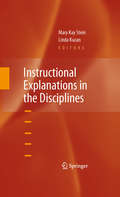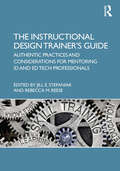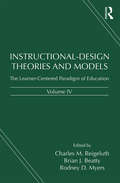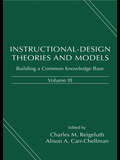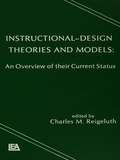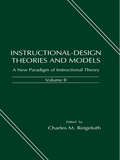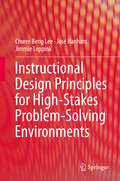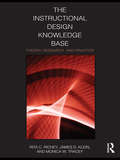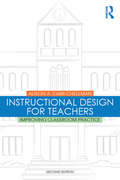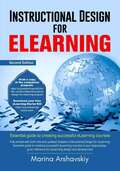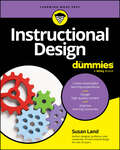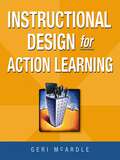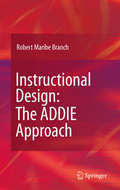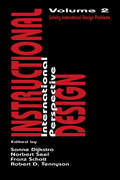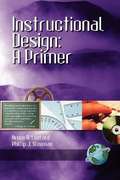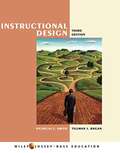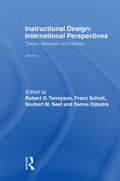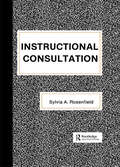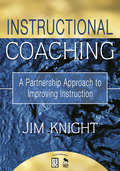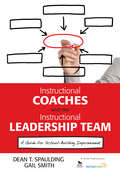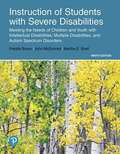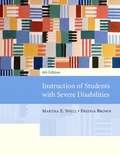- Table View
- List View
Instructional Explanations in the Disciplines
by Linda Kucan Mary Kay SteinIn today's climate of accountability and standards, increasing attention is focused on teacher "quality," with less emphasis on what teachers actually do to interest and engage students in learning. This path-breaking volume addresses this research problem with a clear definition and a content-specific analysis of the most essential teaching moment--the instructional explanation--for vital new perspectives on educational method and process. Rich in examples from science, mathematics, and the humanities, Instructional Explanations in the Disciplines explores a variety of interactive contexts for teaching and learning, which may be collaborative between teachers, students, and others, performed in non-classroom settings, or assisted by technology. The book's subject-matter-specific framework reveals key elements in the process, such as carefully examining the question to be answered, making connections with what is already known, and developing examples conducive to further understanding. Instructional Explanations in the Disciplines is a valuable addition to the education library, giving researchers new methods of unpacking educational process as few books before it.
The Instructional Design Trainer’s Guide: Authentic Practices and Considerations for Mentoring ID and Ed Tech Professionals
by Jill E. Stefaniak Rebecca M. ReeseThe Instructional Design Trainer’s Guide provides foundational concepts and actionable strategies for training and mentoring instructional design and educational technology students to be effective across contexts. ID faculty are charged with bridging the gap between research and practice preparing graduate students for the real-world workforce. This book provides trainers and university programs with authentic learning experiences that better articulate the practices of and demands on design and technology professionals in the field. Through this enhanced perspective, learners will be better positioned to confidently embrace constraints, work among changing project expectations, interact with multiple stakeholders, and convey to employers the skills and competencies gleaned from their formal preparation.
The Instructional Design Trainer’s Guide: Authentic Practices and Considerations for Mentoring ID and Ed Tech Professionals
by Jill E. Stefaniak Rebecca M. ReeseThe Instructional Design Trainer’s Guide provides foundational concepts and actionable strategies for training and mentoring instructional design and educational technology students to be effective across contexts. ID faculty are charged with bridging the gap between research and practice preparing graduate students for the real-world workforce. This book provides trainers and university programs with authentic learning experiences that better articulate the practices of and demands on design and technology professionals in the field. Through this enhanced perspective, learners will be better positioned to confidently embrace constraints, work among changing project expectations, interact with multiple stakeholders, and convey to employers the skills and competencies gleaned from their formal preparation.
Instructional-Design Theories and Models, Volume IV: The Learner-Centered Paradigm of Education
by Charles M. Reigeluth, Brian J. Beatty, and Rodney D. MyersInstructional-Design Theories and Models, Volume IV provides a research-based description of the current state of instructional theory for the learner-centered paradigm of education, as well as a clear indication of how different theories and models interrelate. Significant changes have occurred in learning and instructional theory since the publication of Volume III, including advances in brain-based learning, learning sciences, information technologies, internet-based communication, a concern for customizing the student experience to maximize effectiveness, and scaling instructional environments to maximize efficiency. In order to complement the themes of Volume I (commonality and complementarity among theories of instruction), Volume II (diversity of theories) and Volume III (building a common knowledge base), the theme of Volume IV is shifting the paradigm of instruction from teacher-centered to learner-centered and integrating design theories of instruction, assessment, and curriculum. Chapters in Volume IV are collected into three primary sections: a comprehensive view of the learner-centered paradigm of education and training, elaborations on parts of that view for a variety of K-12 and higher education settings, and theories that address ways to move toward the learner-centered paradigm within the teacher-centered paradigm. Instructional-Design Theories and Models, Volume IV is an essential book for anyone interested in exploring more powerful ways of fostering human learning and development and thinking creatively about ways to best meet the needs of learners in all kinds of learning contexts.
Instructional-Design Theories and Models, Volume IV: The Learner-Centered Paradigm of Education
by Charles M. Reigeluth, Brian J. Beatty, and Rodney D. MyersInstructional-Design Theories and Models, Volume IV provides a research-based description of the current state of instructional theory for the learner-centered paradigm of education, as well as a clear indication of how different theories and models interrelate. Significant changes have occurred in learning and instructional theory since the publication of Volume III, including advances in brain-based learning, learning sciences, information technologies, internet-based communication, a concern for customizing the student experience to maximize effectiveness, and scaling instructional environments to maximize efficiency.In order to complement the themes of Volume I (commonality and complementarity among theories of instruction), Volume II (diversity of theories) and Volume III (building a common knowledge base), the theme of Volume IV is shifting the paradigm of instruction from teacher-centered to learner-centered and integrating design theories of instruction, assessment, and curriculum. Chapters in Volume IV are collected into three primary sections: a comprehensive view of the learner-centered paradigm of education and training, elaborations on parts of that view for a variety of K-12 and higher education settings, and theories that address ways to move toward the learner-centered paradigm within the teacher-centered paradigm. Instructional-Design Theories and Models, Volume IV is an essential book for anyone interested in exploring more powerful ways of fostering human learning and development and thinking creatively about ways to best meet the needs of learners in all kinds of learning contexts.
Instructional-Design Theories and Models, Volume III: Building a Common Knowledge Base
by Charles M. ReigeluthInstructional-Design Theories and Models, Volume III: Building a Common Knowledge Base is perhaps best described by its new subtitle. Whereas Volume II sought to comprehensively review the proliferating theories and models of instruction of the 1980’s and 1990’s, Volume III takes on an even more daunting task: starting to build a common knowledge base that underlies and supports the vast array of instructional theories, models and strategies that constitute the field of Instructional Design. Unit I describes the need for a common knowledge base, offers some universal principles of instruction, and addresses the need for variation and detailed guidance when implementing the universal principles. Unit II describes how the universal principles apply to some major approaches to instruction such as direct instruction or problem-based instruction. Unit III describes how to apply the universal principles to some major types of learning such as understandings and skills. Unit IV provides a deeper understanding of instructional theory using the structural layers of a house as its metaphor and discusses instructional theory in the broader context of paradigm change in education.
Instructional Design Theories and Models: An Overview of Their Current Status
by Charles M. ReigeluthInstructional Design Theories and Models is a thorough yet concise overview of eight of the most comprehensive and best-known attempts to integrate knowledge about effective and appealing instruction. Chapters were written by the original theorists to provide a more accurate and behind-the-scenes look at the theories' development. Instructional Des
Instructional-design Theories and Models: A New Paradigm of Instructional Theory, Volume II
by Charles M. ReigeluthInstructional theory describes a variety of methods of instruction (different ways of facilitating human learning and development) and when to use--and not use--each of those methods. It is about how to help people learn better. This volume provides a concise summary of a broad sampling of new methods of instruction currently under development, helps show the interrelationships among these diverse theories, and highlights current issues and trends in instructional design. It is a sequel to Instructional-Design Theories and Models: An Overview of Their Current Status, which provided a "snapshot in time" of the status of instructional theory in the early 1980s. Dramatic changes in the nature of instructional theory have occurred since then, partly in response to advances in knowledge about the human brain and learning theory, partly due to shifts in educational philosophies and beliefs, and partly in response to advances in information technologies. These changes have made new methods of instruction not only possible, but also necessary in order to take advantage of new instructional capabilities offered by the new technologies. These changes are so dramatic that many argue they constitute a new paradigm of instruction, which requires a new paradigm of instructional theory. In short, there is a clear need for this Volume II of Instructional Design Theories and Models. To attain the broad sampling of methods and theories it presents, and to make this book more useful for practitioners as well as graduate students interested in education and training, this volume contains twice as many chapters, but each half as long as the ones in Volume I, and the descriptions are generally less technical. Several unique features are provided by the editor to help readers understand and compare the theories in this book: *Chapter 1, which discusses the characteristics of instructional theory and the nature of the new paradigm of instruction, helps the reader identify commonalities across the theories. *Chapter forewords, which summarize the major elements of the instructional-design theories, are useful for reviewing and comparing theories, as well as for previewing a theory to decide if it is of interest, and for developing a general schema that will make it easier to understand. *Editor's notes provide additional help in understanding and comparing the theories and the new paradigm of instruction to which they belong. *Units 2 and 4 have introductory chapters to help readers analyze and understand the theories in those units. This is an essential book for anyone interested in exploring new approaches to fostering human learning and development and thinking creatively about ways to best meet the needs of learners in all kinds of learning contexts. Readers are invited to use Dr. Charles Reigeluth's Web site to comment and to view others' comments about the instructional design theories in this book, as well as other theories. Point your browser to: www.indiana.edu/~idtheory
Instructional Design Principles for High-Stakes Problem-Solving Environments
by Chwee Beng Lee José Hanham Jimmie LeppinkThis book examines the types of problems and constraints faced by specialists in the areas of security, medicine, mental health, aviation and engineering. Every day we rely on highly trained specialists to solve complex problems in high-stakes environments, that is, environments involving direct threats to the preservation of human life. While previous work has tended to focus on problem solving in a single domain, this book covers multiple, related domains. It is divided into three parts, the first of which addresses the theoretical foundations, with coverage of theories of instructional design and expertise. Part two covers the five high-stakes domains and offers directions for training in these domains. In turn, part three provides practical guidelines for instructional design in high-stakes professions, including learner analysis, task analysis, assessment and evaluation. The book is intended for a broad readership, including those who operate in high-stress, time-pressure occupations. Trainers at professional organisations can utilise the theoretical frameworks and training strategies discussed in this book when preparing their clients for complex, real-world problem solving. Further, the book offers a valuable resource for academics and graduate students, as well as anyone with an interest in problem solving.
The Instructional Design Knowledge Base
by Rita C. Richey James D. Klein Monica W. TraceyThe Instructional Design Knowledge Base: Theory, Research and Practice provides ID professionals and students at all levels with a comprehensive exploration of the theories and research that serve as a foundation for current and emerging ID practice. This book offers both current and classic interpretations of theory from a range of disciplines and approaches. It encompasses general systems, communication, learning, early instructional, media, conditions-based, constructivist design and performance-improvement theories. Features include: rich representations of the ID literature concise theory summaries specific examples of how theory is applied to practice recommendations for future research a glossary of related terms a comprehensive list of references. A perfect resource for instructional design and technology doctoral, masters and educational specialist certificate programs, The Instructional Design Knowledge Base provides students and scholars with a comprehensive background for ID practice and a foundation for future ID thinking.
Instructional Design for Teachers: Improving Classroom Practice
by Alison A. Carr-ChellmanInstructional Design for Teachers, Second Edition focuses on the instructional design (ID) process specifically for K-12 teachers. The first edition introduced a new, common-sense model of instructional design to take K-12 teachers through the ID process step by step, with a special emphasis on preparing, motivating, and encouraging new and ongoing use of ID principles. This second edition includes new material on design in gaming, cybercharters, online classrooms, and flipped classrooms, as well as special considerations for the Common Core. Each chapter contains framing questions, common errors, easy-to-use rules of thumb, clearly stated outcomes, and examples showing ID in action. The basic model and its application within constructivism and user-design will help teachers adapt from a behavioral approach to a more open, student-centered design approach. Combining basics with strategies to implement this model in the most advanced instructional approaches, this book empowers teachers and learners to use good instructional design with the most recent research-based approaches to learning. Instructional Design for Teachers shows how ID principles can impact instructional moments in positive and practical ways. The book can be used for basic ID courses and introductory curriculum courses, and is accessible to in-service as well as pre-service teachers.
Instructional Design For Elearning: Essential Guide For Designing Successful Elearning Courses
by Marina ArshavskiyThis Instructional Design for ELearning handbook has been updated with the latest design principles and case studies.Fully revised with both new and updated chapters, Instructional Design for eLearning: Essential Guide for Designing Successful eLearning courses is your step-by-step, go-to reference for eLearning design and development. In this book, Marina Arshavskiy presents all the practical information in one place. This second edition includes even more content, examples, case studies, practice exercises, and assessments. You will also find checklists and templates you can immediately apply to your course design. What’s new:• Technical Training• eLearning copyright information• New chapter about Agile ELearning design and development• New information about personalized and augmented learning approaches• New and up-to-date information about eLearning tools• Assessments after each chapter• New tables and templates• Case studies that illustrate eLearning concepts in each chapter
Instructional Design For Dummies
by Susan M. LandThe streamlined, simplified, beginner-friendly introduction to instructional design Instructional Design For Dummies will teach you how to design and build learning content to create effective, engaging learning experiences that lead to improved learning outcomes and skill development. This book breaks down the instructional design process into bite-sized pieces, so you can learn techniques and best practices without getting bogged down in theory. Learn about various instructional design models and frameworks, then discover the different options for designing learning experiences. Take into account learning foundations, goals, and contexts, then create stellar lessons for in-person or virtual delivery. This Dummies guide is your starting place for creating impactful courses, without the technical jargon. Learn the basics of instructional design so you can create meaningful learning experiences Discover techniques that will help you design high-quality content for any context Improve learning outcomes and deliver training content with greater efficiency Skip the complex theories and technical jargon and focus on the info you need to knowThis book is perfect for anyone who needs to develop a course, design a curriculum or training program, or provide educational content without being formally trained in instructional design. It’s also a great supplement to college-level instructional design courses. Whatever you’re teaching, Instructional Design For Dummies will help you teach it better.
Instructional Design for Action Learning
by Geri McardleMcArdle, a human resources practitioner, shows trainers how to use a six-step instructional design system and action learning techniques to engage employees in training. She leads trainers through the process of defining the need for training, design, planning, setting the scene, delivery, and evaluation, and ways to implement fun and memorable activities that are learner-based and meet their needs, learning styles, and level of understanding. Discussion of blended and e-learning strategies and dealing with difficult situations is included. Annotation ©2011 Book News, Inc. , Portland, OR (booknews. com)
Instructional Design: The ADDIE Approach
by Robert Maribe BranchThe Analyze, Design, Develop, Implement, and Evaluate (ADDIE) process is used to introduce an approach to instruction design that has a proven record of success. Instructional Design: The ADDIE Approach is intended to serve as an overview of the ADDIE concept. The primary rationale for this book is to respond to the need for an instruction design primer that addresses the current proliferation of complex educational development models, particularly non-traditional approaches to learning, multimedia development and online learning environments. Many entry level instructional designers and students enrolled in related academic programs indicate they are better prepared to accomplish the challenging work of creating effective training and education materials after they have a thorough understanding of the ADDIE principles. However, a survey of instructional development applications indicate that the overwhelming majority of instructional design models are based on ADDIE, often do not present the ADDIE origins as part of their content, and are poorly applied by people unfamiliar with the ADDIE paradigm. The purpose of this book is to focus on fundamental ADDIE principles, written with a minimum of professional jargon. This is not an attempt to debate scholars or other educational professionals on the finer points of instructional design, however, the book's content is based on sound doctrine and supported by valid empirical research. The only bias toward the topic is that generic terms will be used as often as possible in order to make it easy for the reader to apply the concepts in the book to other specific situations.
Instructional Design: Volume I: Theory, Research, and Models:volume Ii: Solving Instructional Design Problems
by Sanne Dijkstra Norbert M. Seel Franz Schott Robert D. TennysonInstructional design theory and practice has evolved over the past 30 years from an initial narrow focus on programmed instruction to a multidimensional field of study integrating psychology, technology, evaluation, measurement, and management. The growth of instructional design (ID) has occurred because of direct needs, problems, and goals from society. Its application in planning instruction first developed in the United States with the Department of Defense during World War II with the purpose of meeting immediate concerns for effective training of larger numbers of military personnel. From the beginning, ID has rapidly expanded into applications in industrial and executive training, vocational training, classroom learning, and professional education. Although ID has its roots in the U.S., applications and theoretical growth is an international activity. However, literature at the international level is still limited to either individual author contributions or collections primarily represented by single countries. As a result, there is no standard reference source that contains the rich variety of theories and applications to form the international foundation for the field. The goal of this two-volume set is to establish international foundations for ID theory, research, and practice within the framework of the two following objectives: * to identify and define the theoretical, research, and model foundations for ID, and * to bridge the gap between ID foundations and application. Volume I includes chapters on philosophical and theoretical issues on learning theory and ID models. Volume II provides an overview of the state of the art of solving ID problems. The contributors offer contrasting points of view which provide a rare opportunity to see the diversity and complexity in the field. The editorial committee has selected a wide range of internationally known authors to make presentations in the topic areas of the field.
Instructional Design: A Primer
by Bruce R. Ledford Phillip J. SleemanAt the time of this writing the authors of Instructional Design: System Strategies have a combined experience of more than 75 years in the ?eld of instructional technology in its various guises including Educational Media, Instructional Media, Educational Media and Technology, Instructional Media and Technology, Instructional Communication, and Audiovisual. This experience includes colleges and universities, the military as instructors and as consultants; public education as classroom teachers, consultants, and conductors of workshops and seminars; with business and industry as corporate trainers and trainers of trainers. Combined, they have published over 350 articles and research documents in professional referred journals, authored or coauthored, or made signi?cant contributions to 35 books. Together, they have taught courses in instructional design/technology at the following universities in the United States: Auburn University, Boston University, Harvard University, University of Alabama, University of Arizona, University of Connecticut, University of Massachusetts and have conducted workships, courses and seminars in Barbados, Canada, Mexico, Colombia, Peru, Ecuador, England, Scotland, Italy, France, Germany, Puerto Rico, St. Vincents,and Switzerland. Additionally, they have produced and directed educational television programs, ?lms, ?lmstrip series, transparency series, curriculum units, and computer software for both the world wide web and standalone software, radio for national distribution, and have founded and edited three international journals for national and international distribution. Dr. Sleeman is the founding editor of The International Journal of Instructional Media presently in its 32nd year of publication of wich Dr. Ledford is Associate Editor.
Instructional Design
by Patricia L. Smith Tillman J. RaganA well-documented, theory-based treatment that focuses on instructional design’s application to industry and K-12 education. Offers extensive procedural assistance, emphasizing the foundations and first principles upon which most of the models and procedures in the field are built. An Extended Example (now online) showcases applications of concepts and techniques using a single subject area and course (Digital Photography).
Instructional Design: Volume I: Theory, Research, and Models:volume Ii: Solving Instructional Design Problems
by Robert D. Tennyson Franz Schott Norbert M. Seel Sanne DijkstraInstructional design theory and practice has evolved over the past 30 years from an initial narrow focus on programmed instruction to a multidimensional field of study integrating psychology, technology, evaluation, measurement, and management. The growth of instructional design (ID) has occurred because of direct needs, problems, and goals from society. Its application in planning instruction first developed in the United States with the Department of Defense during World War II with the purpose of meeting immediate concerns for effective training of larger numbers of military personnel. From the beginning, ID has rapidly expanded into applications in industrial and executive training, vocational training, classroom learning, and professional education. Although ID has its roots in the U.S., applications and theoretical growth is an international activity. However, literature at the international level is still limited to either individual author contributions or collections primarily represented by single countries. As a result, there is no standard reference source that contains the rich variety of theories and applications to form the international foundation for the field. The goal of this two-volume set is to establish international foundations for ID theory, research, and practice within the framework of the two following objectives: * to identify and define the theoretical, research, and model foundations for ID, and * to bridge the gap between ID foundations and application. Volume I includes chapters on philosophical and theoretical issues on learning theory and ID models. Volume II provides an overview of the state of the art of solving ID problems. The contributors offer contrasting points of view which provide a rare opportunity to see the diversity and complexity in the field. The editorial committee has selected a wide range of internationally known authors to make presentations in the topic areas of the field.
Instructional Consultation (School Psychology Series)
by Sylvia RosenfieldRecent changes in policy and law, along with advances in research, are making it necessary for an increasing number of school psychologists, special educators, and teacher consultants to develop skills in areas other than psychoeducational assessment. In response to this need, many professionals and students are expanding their careers to include the field of instructional consultation -- the synthesis of school- based consultation techniques and a solid knowledge of effective instructional practices. This book examines the major themes of instruction and gives a step-by-step outline of the consultation process from referral to the final report. Recent changes in policy and law, along with advances in research, are making it necessary for an increasing number of school psychologists, special educators, and teacher consultants to develop skills in areas other than psychoeducational assessment. In response to this need, many professionals and students are expanding their careers to include the field of instructional consultation -- the synthesis of school- based consultation techniques and a solid knowledge of effective instructional practices. This book examines the major themes of instruction and gives a step-by-step outline of the consultation process from referral to the final report.
Instructional Coaching: A Partnership Approach to Improving Instruction
by Jim KnightAn innovative professional development strategy that facilitates change, improves instruction, and transforms school culture! Instructional coaching is a research-based, job-embedded approach to instructional intervention that provides the assistance and encouragement necessary to implement school improvement programs. Experienced trainer and researcher Jim Knight describes the "nuts and bolts" of instructional coaching and explains the essential skills that instructional coaches need, including getting teachers on board, providing model lessons, and engaging in reflective conversations. Each user-friendly chapter includes: <p><p> First-person stories from successful coaches <p> Sidebars highlighting important information <p> A "Going Deeper" section of suggested resources <p> Ready-to-use forms, worksheets, checklists, logs, and reports
Instructional Coaches and the Instructional Leadership Team: A Guide for School-Building Improvement
by Ms Gail M. Smith Dean T. SpauldingSupercharge school improvement with instructional coaches! How can coaches seamlessly integrate themselves into the fabric of a school and help teachers improve their practice from day one? This unique companion provides an inside look at the day-to-day work of an instructional coach and offers field-tested activities, materials, and data collection forms for coaches and instructional leadership teams. The authors address common challenges, including: <p><p> Observing classrooms and providing formative feedback; Reaching out to the hesitant or resistant teacher; Adapting data and analysis into usable information for the team; Recruiting, training, and supporting new instructional coaches.
Instruction Of Students With Severe Disabilities
by Fredda Brown John McDonnell Martha SnellIn this authoritative guide, leading scholars and researchers present information and evidence-based practices for dealing with the full range of curriculum and instruction for individuals with severe intellectual disabilities and autism. Case studies throughout Instruction of Students with Severe Disabilities look at students of various ages and with a variety of disabilities, and each chapter includes an application to a student with autism. The content is presented with citations of supportive research, and evidence-based practices are presented in clearly defined ways to ensure that teachers understand the practices and how to apply them in their own classrooms.
Instruction of Students with Severe Disabilities
by Martha E. SnellThis book examines the principles behind teaching students with severe and multiple disabilities. This edition includes a stronger focus on positive behavior interventions and supports, and additional strategies on peer relationships.
Instruction of Students with Severe Disabilities
by Martha E. Snell Fredda BrownThe seventh edition of this widely-adopted text for special educators addresses the full-range of curriculum and instructional topics involved in educating individuals with moderate, severe, and multiple disabilities. Evidence-based practices are presented in clearly-defined ways so that teachers can easily understand the research presented and apply it in the real classroom. All chapters in the book are unique, written by leaders in the field known for their research and writing on the specific topics. Case studies of students are applied to chapter content in vignettes, tables, and figures found throughout the chapters, and the textbook rests on a solid evidence-base with research citations provided. The new edition features many new updates including: a greater emphasis on teaching students with autism; six new chapters authored by experts in the field; more information on teaching methods supported by research, peer support, teaching academic skills, the process for planning and implementing instruction within general education classrooms, transition planning, and alternate assessment.
